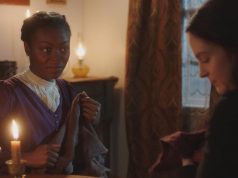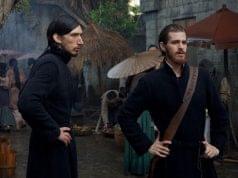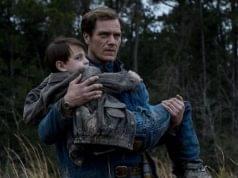Nearly two dozen examples of Mormon Cinema — movies made by, for and about Mormons — have been released since Richard Dutcher began the trend with “God’s Army” in 2000. They have run the gamut from great to awful, from comic to tragic, from admirable to laughable, but with the possible exception of Ryan Little’s “Saints and Soldiers,” they have not been innovative. The genre, though prolific, is only five years old. Writers and directors are still finding out what works.
So it’s fitting that the man who started it would return, after a four-year absence (since “Brigham City”), to take Mormon Cinema to a new level. “States of Grace” is as accomplished a film as the movement has seen. It’s a veritable epic of spiritual drama in which every character is well-drawn and well-played, multiple storylines are juggled, and things like camera movement and editing are used as tools of art, not just tools of mechanics.
It’s been incorrectly termed a sequel to “God’s Army,” but “States of Grace” shares only two minor characters with that film. It has the same setting and situation: Mormon missionaries in Santa Monica. But where “God’s Army” focused on several missionaries and had a here’s-what-it’s-like, “day in the life” feel to it, “States of Grace” focuses on one pair of elders and has stories that are intentionally atypical. The characters don’t feel like prototypes (the Obedient Elder, the Slacker Elder, etc.), but like fully realized, three-dimensional people.
The missionaries are Elder Farrell (Lucas Fleischer) and Elder Lozano (Ignacio Serricchio). Farrell is non-athletic and perhaps nerdy, a stickler for rules but a nice, happy person. He’s the sort of missionary who seems never to have existed before he was ordained; we have no idea where’s he from or what he was like before he turned 19.
Lozano, on the other hand, rolled with Latino gangs before his conversion a few years back and still bears the tattoos and scars from that life. Yet in his own words, “I was a better convert than a missionary.” He goes home in three weeks, but he’s been slacking off for months. He’s the senior companion, but it’s Farrell who makes the appointments.
Lozano is roused into a new state of ambition, however, when he and Farrell are caught in the crossfire of a drive-by shooting, after which Lozano helps save the life of one of the victims, an African American gangbanger named Carl (Lamont Stephens). When he recovers, Carl seeks out the missionaries — well, Lozano; he wonders why “that white boy” is always following him around — to gain assistance in setting his life in order. Carl has realized that life is short; Lozano now realizes that his time as a missionary is far spent, too. They are in a position to do each other much good.
In his new-found Christian fervor, Lozano convinces Farrell to let them bring an ailing homeless preacher named Louis (Jo-sei Ikeda) into their apartment for a few days. Would it make more sense to take him to a shelter, despite his protests? Yes, of course. I’m inclined to accept this unlikely turn of events, however, because of the flavor Louis adds to the film. He has his own story of spiritual woe, and it’s noteworthy that his decidedly non-Mormon expressions of faith (he’s Pentecostal) are treated with acceptance. This is the first Mormon Cinema film to exist in a truly multi-cultural, multi-religious world without making a big deal out of it.
The elders’ neighbor is a young woman named Holly (Rachel Emmers), a struggling actress who takes a friendly shine to the missionaries and cooks dinner for them and their new houseguest. To avoid breaking the rules about having single young ladies in their home, all the dinners after the first one are conducted on the roof of their apartment building. While Lozano’s thoughts are preoccupied with Carl, Farrell sees that Holly is a lost soul, too, which Rachel Emmers conveys in a poignant and sublime monologue that runs fully six minutes.
There are frequent allusions in the film to the temptations of the flesh; working in Santa Monica so close to the beach, pretty young things in swimsuits are part of the landscape. After a pair of particularly fetching women pass them on the sidewalk, Farrell quickly suggests an antidote: “When you have a dirty thought, sing a hymn.”
Lozano is reluctant. “My bishop used to tell me that,” he says. “Now every time they sing a hymn in church, I have a dirty thought.”
Back to Carl. Though he takes the missionary discussions quickly and is eager to be baptized, he has a hard time forsaking his lifestyle of revenge and street justice. He was nearly killed by a rival gang, you’ll recall. Surely he can’t be expected to just let that go.
All of these stories intermingle and are eventually given some closure, though I don’t want to say much more about them for fear of getting into “spoiler” territory. (It is unfortunate that Louis’ story reaches its conclusion in a brief post-finale scene that ruins the mood set by the actual finale.) Suffice it to say that the movie kicks the legs out from under us more than once, not with “shocking” surprises but with developments that arise naturally from what has already happened.
Through it all, Dutcher directs with his eye affixed on conveying the themes of his story, never being distracted from that goal even when he takes a chance and tries something stylish in the way he tells it. In one memorable sequence, he intercuts between two scenes: one in which a man is being confirmed in church, the other in which someone is being murdered on a street. (The fact that this is an homage to the baptism/mob hit sequence in “The Godfather” is evidence enough that “States of Grace” has lofty influences.) One character opens his eyes as the other closes his; one’s new life is beginning while the other’s is ending. Then we cut to overhead shots: the men standing in a circle around the man they have just confirmed, and the men on the street standing in a circle around the person they have just killed.
Maybe a stunt like this draws too much attention to itself, and maybe it even pulls you out of the scene a little bit — but my goodness, at least Dutcher is TRYING something! At this still-early stage in the Mormon Cinema movement, I’m thrilled to see a director attempting any kind of visual symbolism, regardless of whether it works or not (and the example I cited mostly does).
I mentioned the story’s surprises. At one turn of events, I can honestly say I was devastated, to the point of disbelief; I figured I had somehow misread the scene. Surely what I thought had happened had NOT actually happened! That’s not the way this story was supposed to go! Which is what the character must have felt, too, and it’s a credit to Dutcher and to the talent of his actors (Serricchio and Fleischer in the leads, especially) that an audience can be made to empathize as deeply as we do here.
What is most extraordinary about the film is that it addresses mature spiritual themes with such astonishing depth, creating a world where every character is at or near a crossroads in his or her path to God. It has the audacity to suggest that there is life after sin, that even good, decent people transgress, sometimes quite seriously, and that EVERYONE needs redemption.
The heartache of sin is succinctly conveyed when a lost soul bewails his sorrow for his mistakes and is told, “It’s going to be all right.” His piteous, momentarily disbelieving response is: “How?”
What he soon remembers, in a truly beautiful final sequence, is that Jesus Christ is the way, and that while some sins seem irreparable, such is not the case. “States of Grace” is unabashedly Christian in its message, and it’s the most faith-affirming, uplifting film I have seen in a long time.
A- (2 hrs., 6 min.; )





